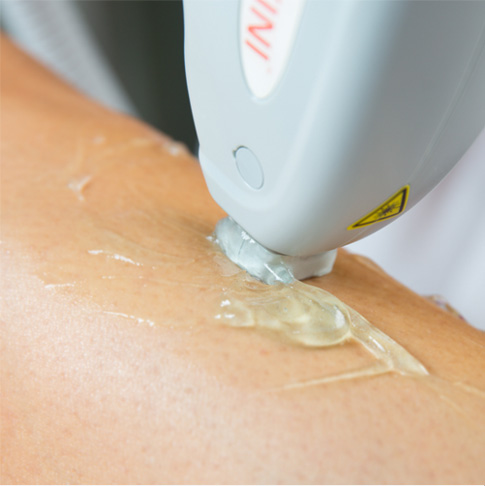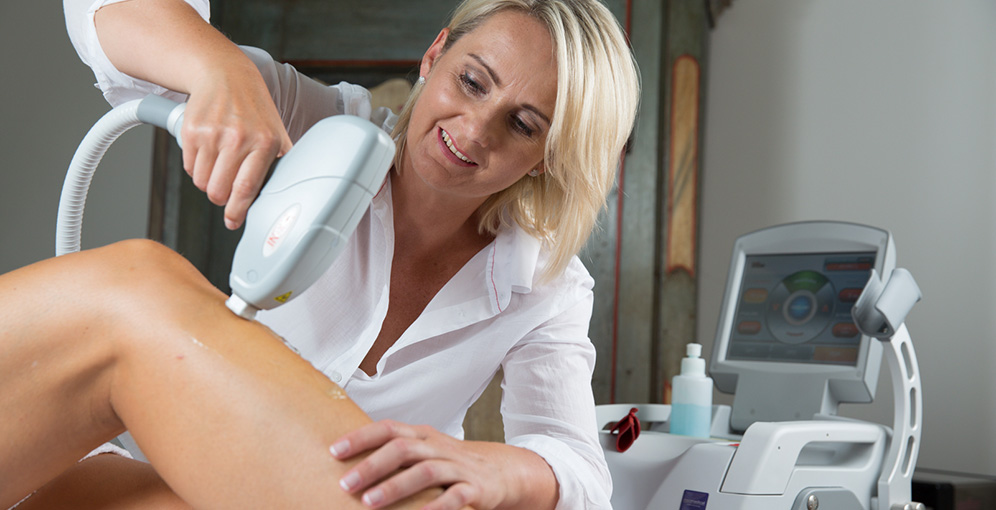The secret of the perfect wave-length
Deutsch
While conventional methods of hair removal yield rather short effects and are often quite painful, the latest generation of lasers makes it possible to remove annoying hairs almost painlessly and for the long term.
All methods of hair removal available up to date do not yield satisfactory results, for different reasons. Being one of the most commonly used means, shaving requires constant follow-up treatment and may lead to skin irritation. Plucking, epilating, or waxing may cause scars and ingrown and inflamed hair follicles. In addition, the annoying hairs have to grow for several days before the can be removed anew.
If you want certain skin areas to be smooth for a longer period of time, you can achieve this with a laser treatment. Even the problem of ingrown and inflamed hair follicles can be avoided this way.
Laser epilation has been proven reliable on all hairy parts of the body except for the eye brows. Women especially appreciate the possibility of hair removal in the armpits, the bikini zone as well as on the legs. However, an increasing number of men seize the opportunity to have annoying hair removed from breast or back. Depilation of the armpits can reduce body odour.
What is more effective, laser or IPL flashlamps?
While IPL (Intense Pulsed Light) devices use broad-spectrum, low-energy light, lasers deploy a defined wavelength yielding very high efficiency. Accordingly, the time necessary for a treatment is short.
Lasers may only be applied under the supervision of a physician in a medical facility or a doctor’s office, whereas IPL devices with reduced power may be used by any epilation or cosmetics centre.
.
What happens during laser epilation?

First of all, a water-based gel is applied to the skin areas to be treated. The handheld device of the system is then set to the skin, sending a light impulse – the perfect wavelength -, which will feel like a little sting. At the same time, the outer dermal layer is cooled.
This high-energy beam penetrates the outer part of the skin, is specifically absorbed by the brown pigment (melanin) of the hair and converted to heat. This permanently damages the cells around the hair that are responsible for its growth. The hair becomes loose and falls out. The thickness of the hair determines the period of time this will take. The best result can be observed after two to three weeks.
Since this high-energy beam of light especially addresses the dark pigment, red, blond, or grey hairs are less affected.
Silk-smooth skin in about six sessions
Before you start with a laser epilation treatment, it is recommended to abstain from tanning in the sun or a solarium or by means of a self-tanning lotion. You may shave your hair to skin level one day prior to the treatment. Hair removal by epilation, waxing or plucking should not be applied during the preceding four to six weeks.
Human hair grows in several phases. A laser will only damage those hairs that are in an early stage of growth. In order to get hold of every hair in this sensitive phase, it will take six to eight sessions until an optimally smooth skin is achieved. Between the sessions, a period of four to six weeks has to elapse so that the hairs can develop to this phase of growth.

Will it hurt? Are there any risks or side-effects?
First things first: The established methods of removing annoying hair are much more painful. However, it is still possible that you might feel small stings during the treatment.
In order to avoid this, I use a laser with integrated contact cooling by sapphire tips. After the treatment, your skin may be a little red – similar to a sunburn – but this can be countered by cooling the affected area.
Will I really be rid of all annoying hairs?
The best result is achieved with light skin and dark hair. The high-energy beam affects red, blond, and grey hair much less. Colour, density and depth of the hair as well as the hormone level and the genetic disposition also influence the final result. The Vikini High Power Diode Laser disposes of three pulse types, making a customer-oriented treatment of different hair and skin types possible.
From follicles „sleeping“ in the skin, new hair can develop after some time. In order to keep the skin as smooth as possible, it is recommended to repeat treatment in regular intervals of about one to two years.
